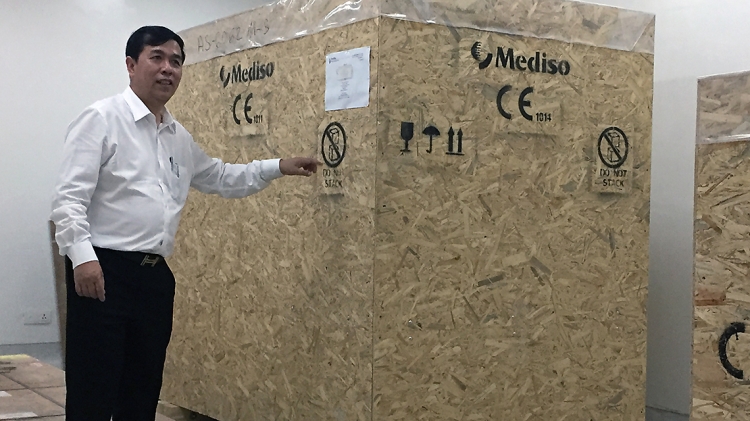Phnom Penh, Cambodia – When after medical school, he chose oncology as his field of specialization, many of his colleagues called Sokha Eav crazy. ‘Why pick a discipline in which there is no future in this country,’ he recalls his friends asking. Fast forward twenty years and Eav, who is the head of the Onco-Hematology Department at the Calmette Hospital in central Phnom Penh, is about to realize his dream: the establishment of Cambodia’s first ever dedicated cancer care centre. “It has taken me a long time, but I have proven them wrong,” he says with a smile.
The National Cancer Centre at Calmette Hospital in central Phnom Penh is scheduled for inauguration before the end of the year. Much of its equipment, including those donated by the IAEA such as a gamma camera used for body scans and a shielded fume hood to prepare radiopharmaceuticals, are still in boxes or being installed, while its radiotherapy machine – which will only be the second in the country – is on its way from the United States. But construction workers and the staff of the Onco-Hematology Department, which will form the core of the new Centre are working round the clock to complete the work on schedule.
Cancer is a growing problem in Cambodia, as in much of the developing world. Due to changing life habits brought about by higher living standards and a rapid increase in life expectancy, cancer is becoming one of the main causes of death in the country. While Cambodia does not have a national cancer registry, it is estimated that it has around 15,000 cases of cancer a year out of a population of 15 million. Around 90% of these patients would require some form of radiotherapy, but Cambodia’s only radiotherapy machine, at the Khmer-Soviet Friendship Hospital in Phnom Penh, has the capacity to treat only around 500 people annually. Around 1,500 patients can afford to pay for treatment in neighbouring countries – leaving the vast majority of cancer sufferers without access to radiotherapy.
Eav’s plan will be a major step towards changing that. The Centre will open with one radiotherapy machine, and two more are planned to be added in coming years. Then, by 2025, two Regional Cancer Centres with their own radiotherapy and nuclear medicine facilities will open, one in the north and another in the west of the country, bringing cancer care access to 70% of the population. “That is still not full coverage, but a lot better than where we are today,” Eav said.
Cancer diagnosis
Plans also include the installation of a PET-CT machine for diagnosis and a cyclotron for the production of radiopharmaceuticals to diagnose cancer. The establishment of a nuclear medicine facility has been a key component to the country’s comprehensive approach to cancer care, said Thomas Pascual of the Nuclear Medicine and Diagnostic Imaging Section at the IAEA. “Proper diagnosis is the first step towards treatment,” he said.
Getting this far has not been easy, Eav recalls. Initially there was much fear of radiation, even among health officials and hospital administrators. Eav showed them improving cancer statistics from neighbouring countries, and pointed to the IAEA’s safety standards and support in protecting the health of workers and patients. Once government officials realized the importance of cancer care, they dedicated resources towards building the Centre and purchasing its equipment – a total of US $36 million over the last three years.
What money could not buy, however, was expertise in operating the new equipment, Eav said. This is where support from the IAEA has been invaluable, he said. Half of his core staff, including radiation oncologists, medical physicists, radiotherapists as well as a radiopharmacist, a nuclear medicine physician and nuclear medicine technologists have participated in IAEA fellowships and trainings in hospitals in the region and in Europe. “They have learned not only technical skills, but also ways of dealing with patients,” Eav said. “To create a good ambiance is very important, particularly when dealing with a disease like cancer.”
The total value of IAEA technical cooperation projects in Cambodia in cancer care and nuclear medicine has topped EUR 1.2 million over the last few years, said Mykola Kurylchyk, who manages the IAEA’s projects in Cambodia. “It was worth every cent,” he said. “The results speak for themselves.”
“If there were only one thing I could change in cancer care in Cambodia, it would be early diagnosis.”







